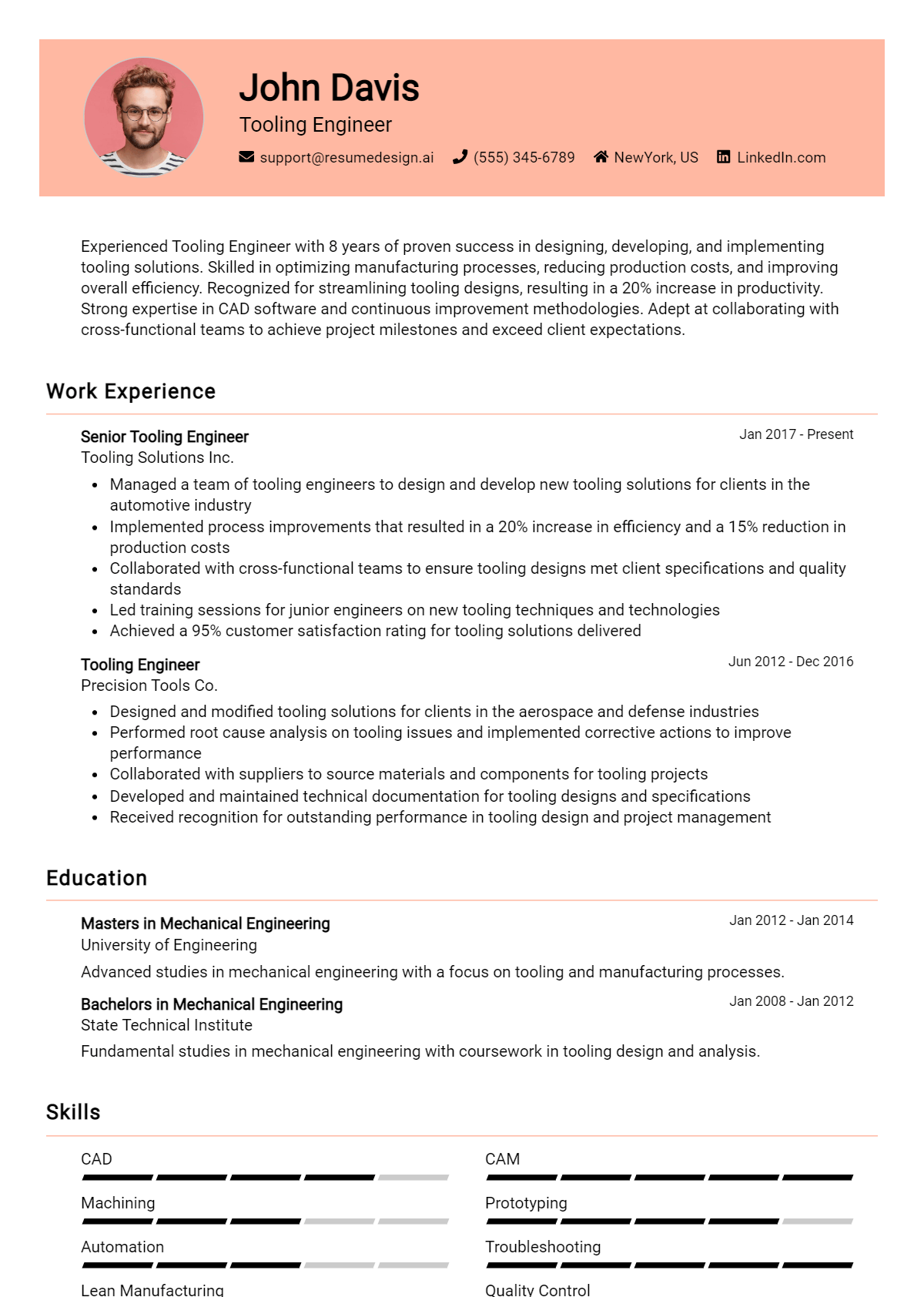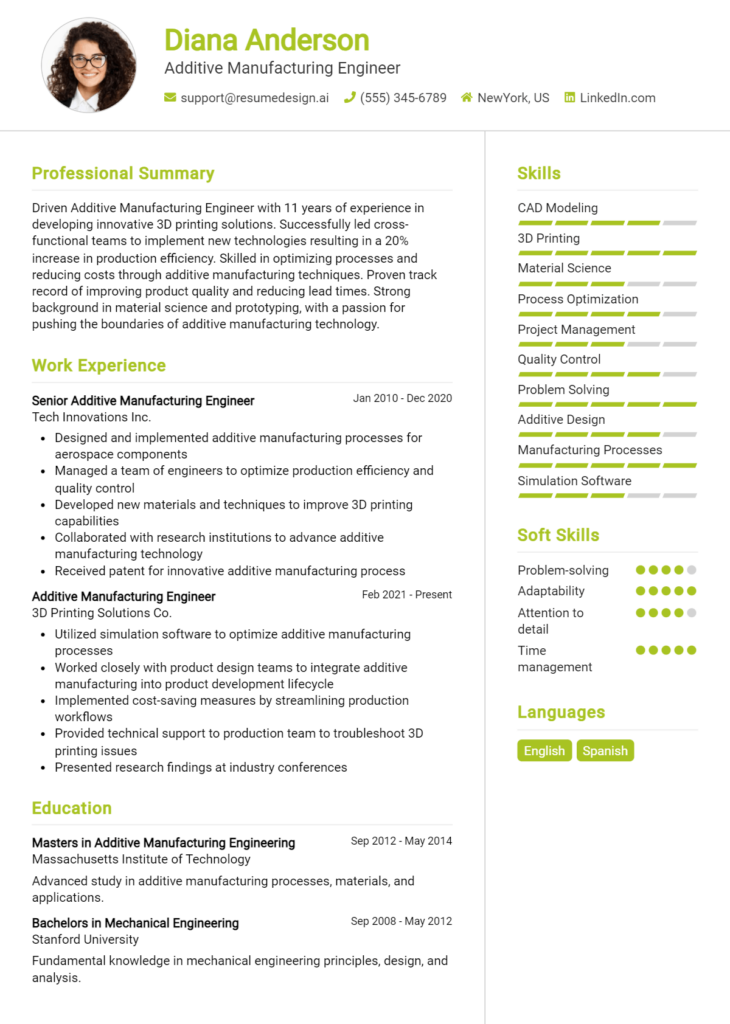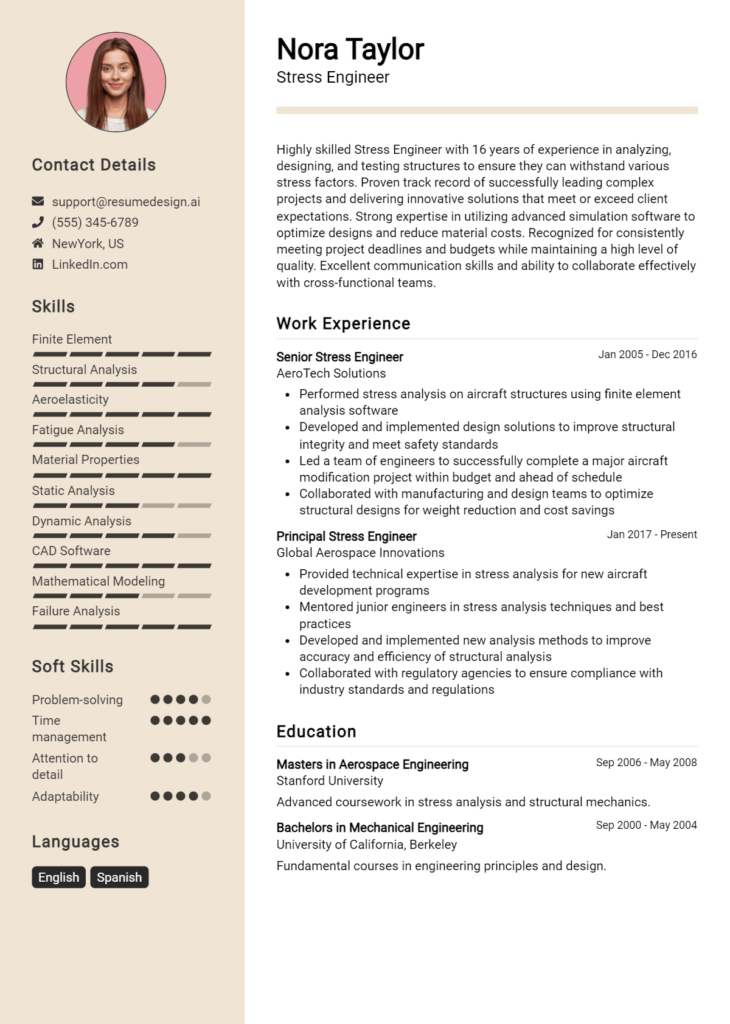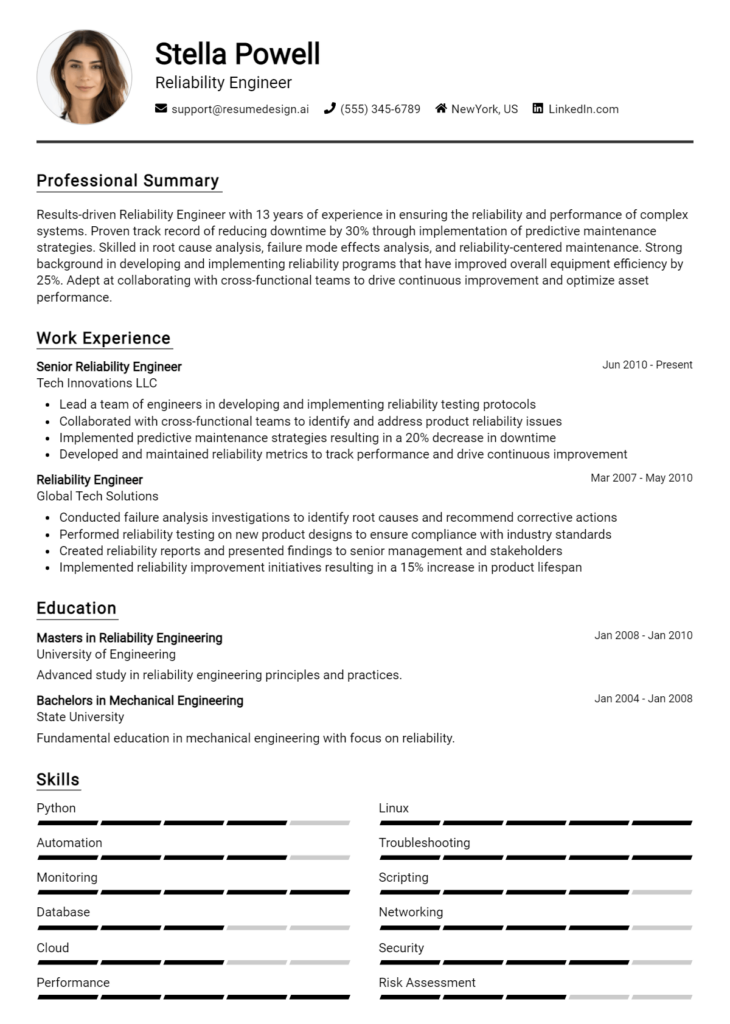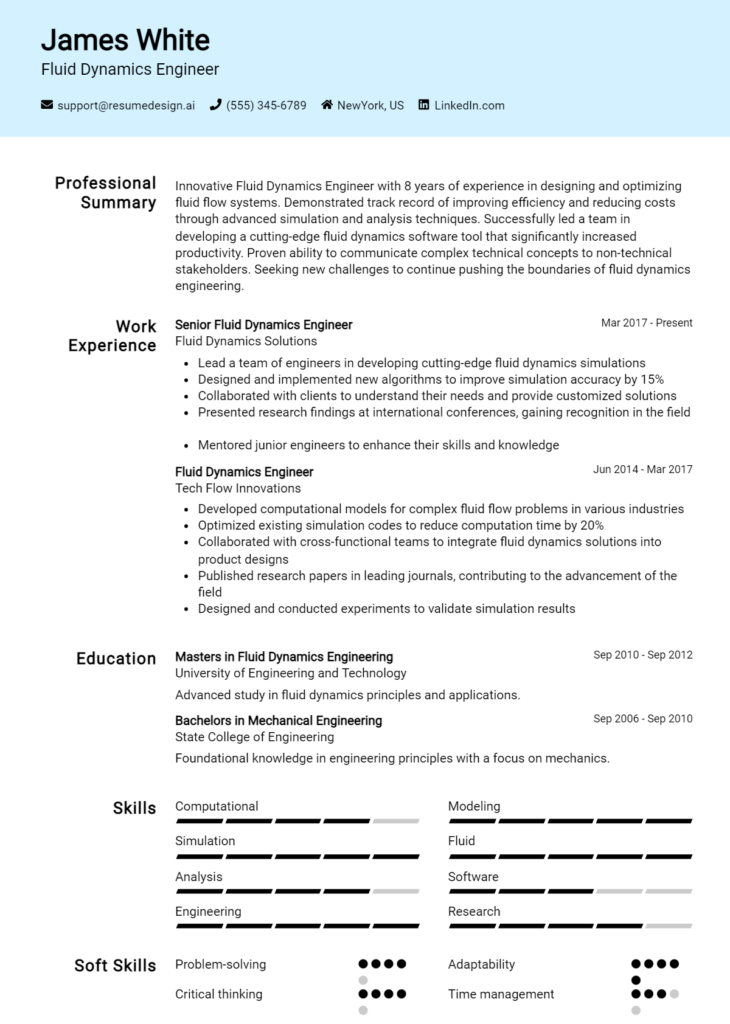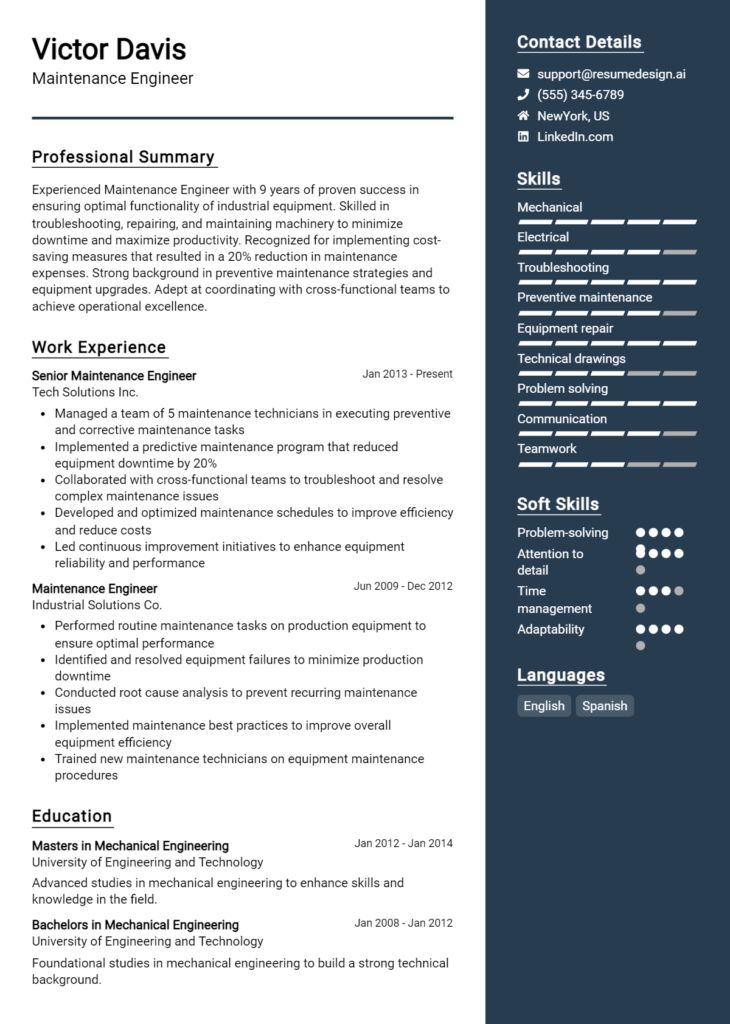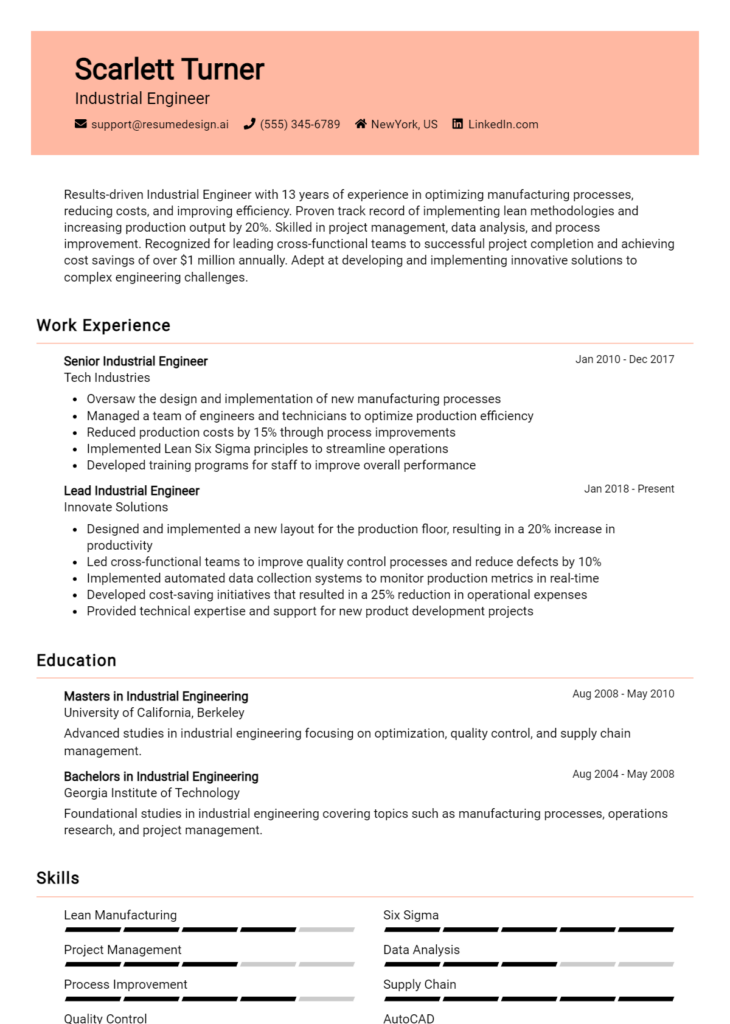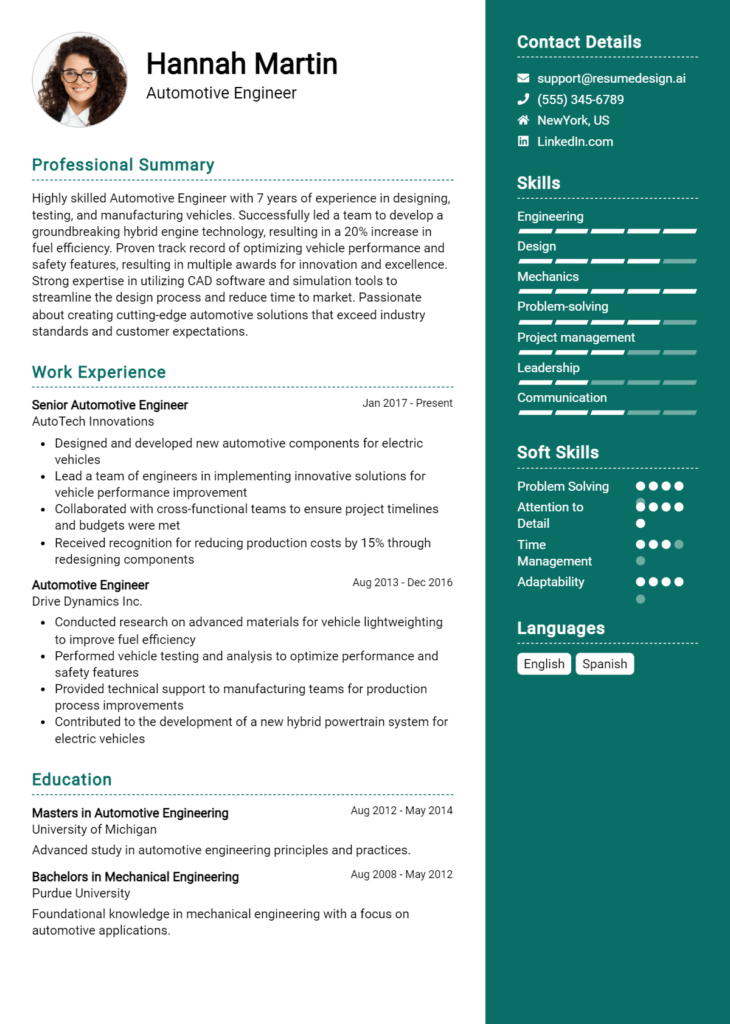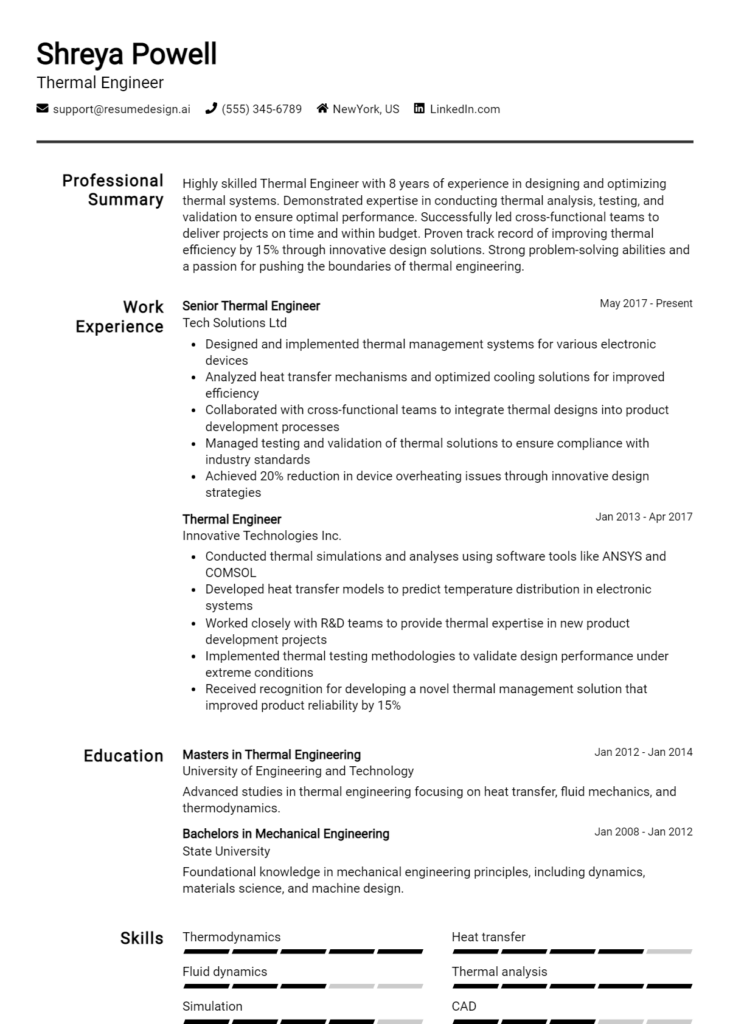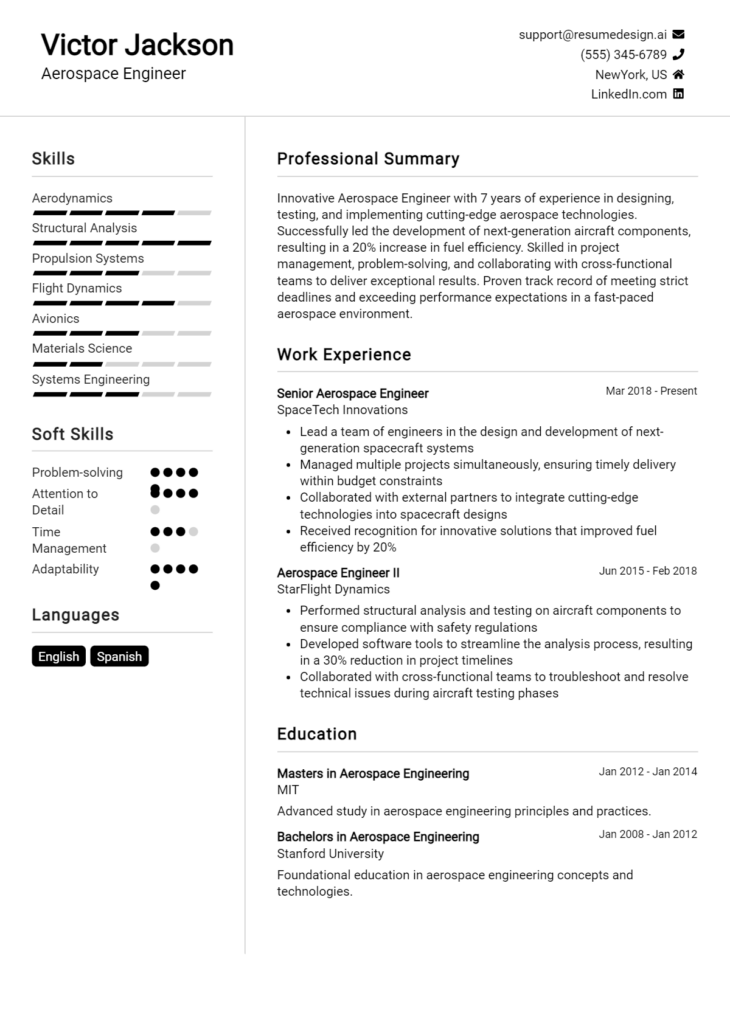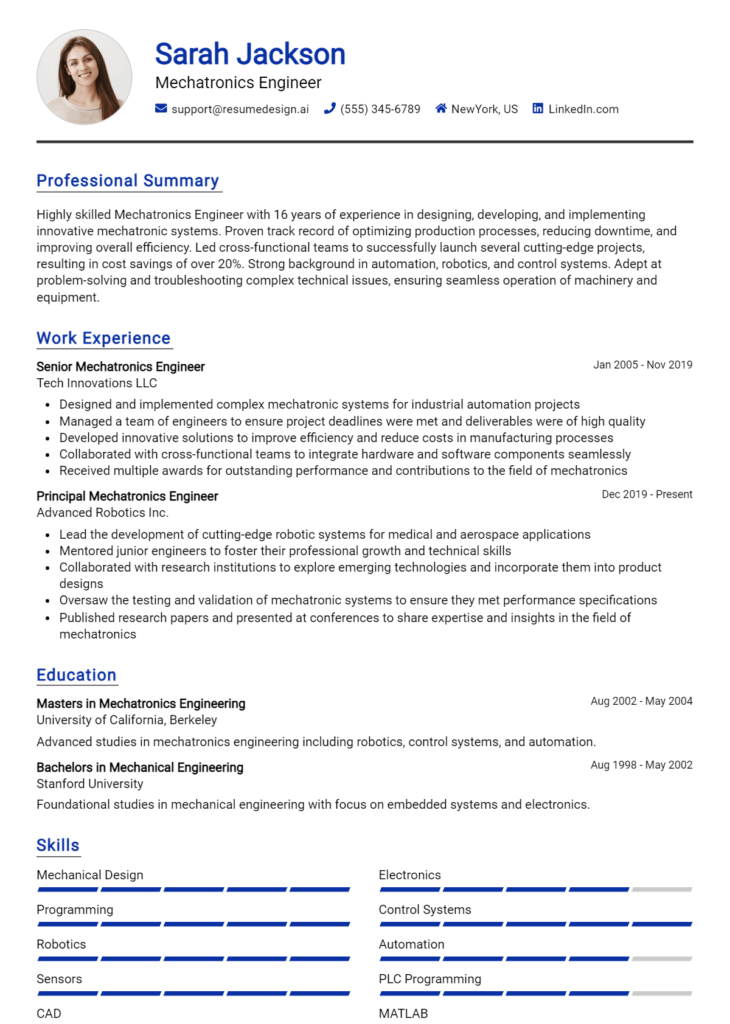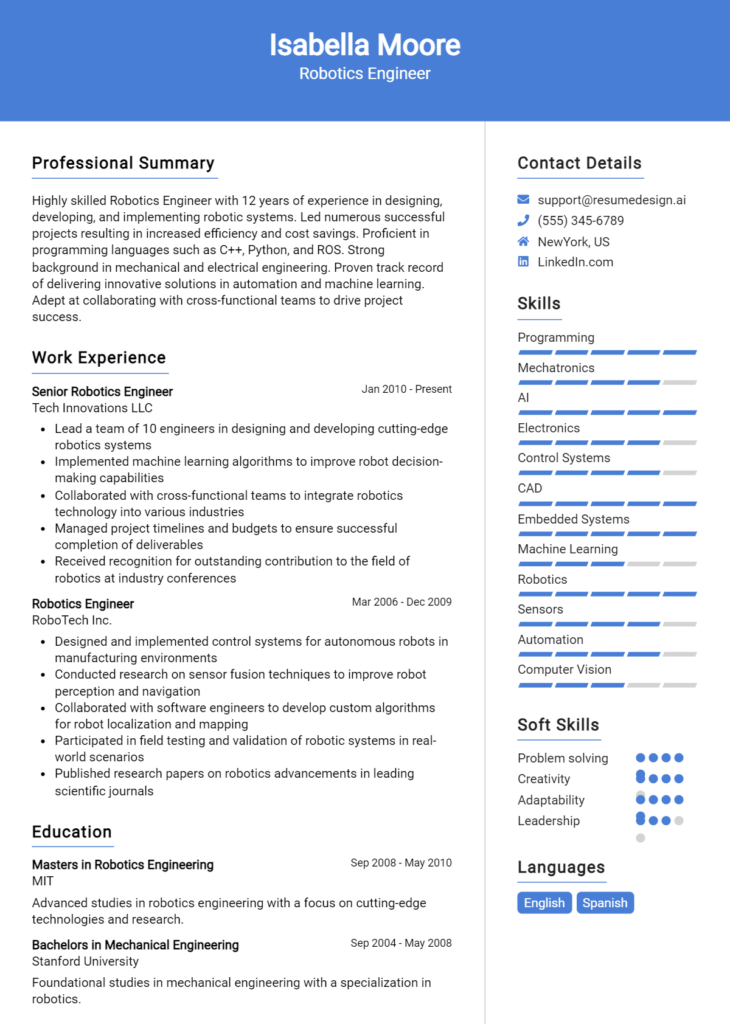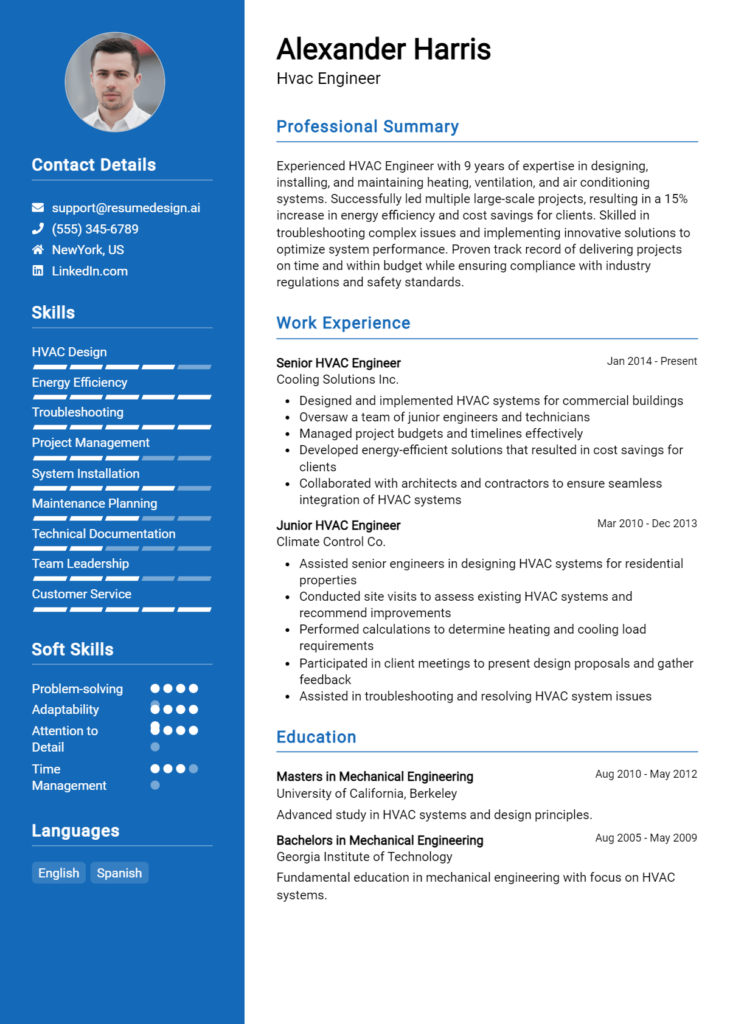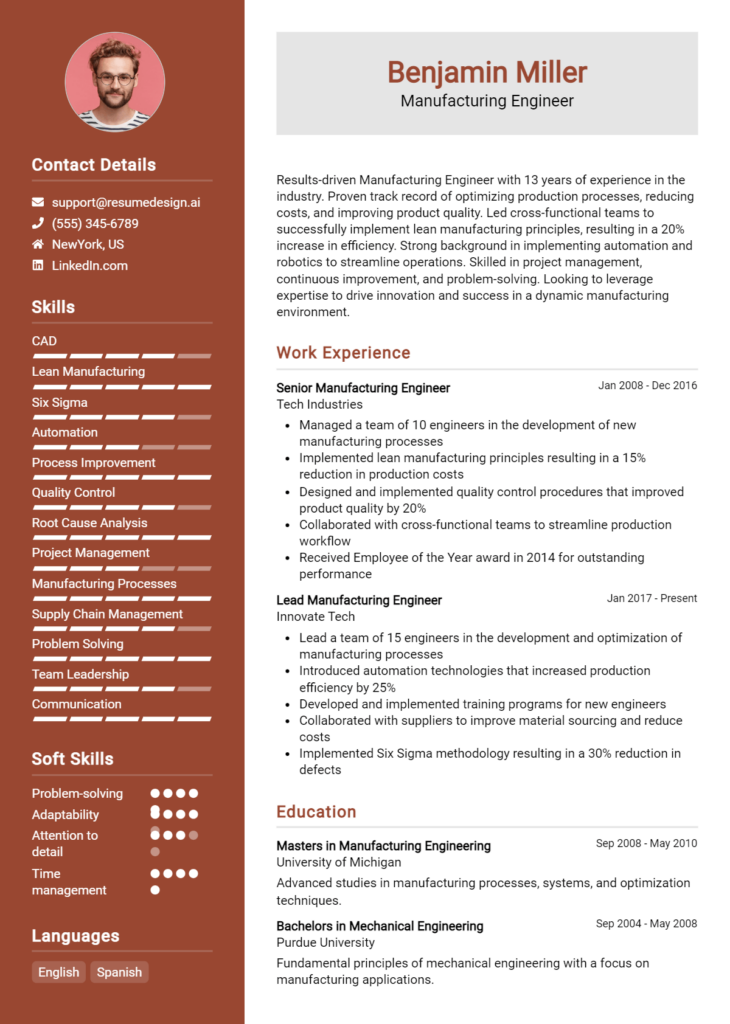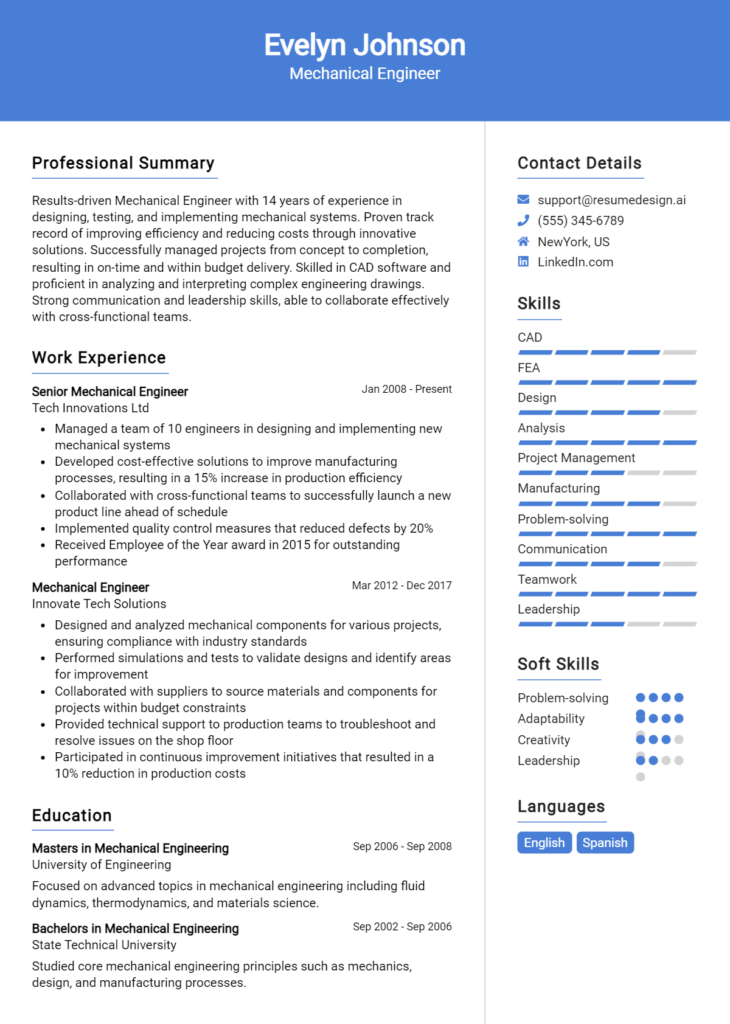Tooling Engineer Core Responsibilities
A Tooling Engineer plays a critical role in bridging various departments, from design to production, ensuring that tooling processes are efficient and effective. Key responsibilities include designing, developing, and maintaining tools and fixtures, while also collaborating with engineering, manufacturing, and quality assurance teams. To excel in this role, strong technical expertise, operational knowledge, and problem-solving skills are essential. These qualifications not only support product development but also contribute to organizational goals. A well-structured resume can effectively showcase these competencies, enhancing career opportunities.
Common Responsibilities Listed on Tooling Engineer Resume
- Design and develop tooling and fixtures for manufacturing processes.
- Collaborate with cross-functional teams to optimize product designs.
- Conduct feasibility studies and cost analysis for tooling projects.
- Perform root cause analysis and implement corrective actions.
- Maintain and update tooling documentation and specifications.
- Oversee the tooling manufacturing process and ensure quality standards.
- Train and support production staff on tooling usage and maintenance.
- Monitor tooling performance and recommend improvements.
- Develop and implement tooling maintenance schedules.
- Analyze and resolve tooling-related production issues.
- Evaluate new tooling technologies and materials.
- Ensure compliance with safety and regulatory standards.
High-Level Resume Tips for Tooling Engineer Professionals
In today's competitive job market, a well-crafted resume is crucial for Tooling Engineer professionals looking to make a strong first impression on potential employers. Your resume serves as a marketing tool that highlights your unique blend of skills, industry knowledge, and achievements. It needs to effectively communicate your value and demonstrate how your expertise aligns with the specific needs of the employer. This guide aims to provide practical and actionable resume tips specifically tailored for Tooling Engineer professionals, ensuring that your resume not only stands out but also resonates with hiring managers.
Top Resume Tips for Tooling Engineer Professionals
- Tailor your resume for each job application by closely aligning your skills and experiences with the job description.
- Highlight relevant experience by including specific roles where you developed tooling systems or improved manufacturing processes.
- Quantify achievements with metrics, such as percentage improvements in production efficiency or cost savings resulting from tooling innovations.
- Showcase industry-specific skills such as CAD software proficiency, knowledge of materials, and understanding of manufacturing techniques.
- Include certifications and training that are relevant to tooling engineering, such as Six Sigma or Lean Manufacturing certifications.
- Utilize action verbs to describe your responsibilities and achievements, making your impact clear and compelling.
- Incorporate keywords from the job posting to optimize your resume for applicant tracking systems (ATS).
- Keep your resume concise and focused, ideally one page, to ensure hiring managers can quickly grasp your qualifications.
- Consider including a summary statement that encapsulates your expertise and career goals, tailored to the tooling engineering field.
By implementing these tips, Tooling Engineer professionals can significantly increase their chances of landing a job in the field. A focused and well-structured resume not only showcases your qualifications but also positions you as a standout candidate, ready to contribute to the success of potential employers.
Why Resume Headlines & Titles are Important for Tooling Engineer
In the competitive field of engineering, particularly for Tooling Engineers, resume headlines and titles play a crucial role in making a lasting first impression on hiring managers. A well-crafted headline can immediately capture attention and succinctly summarize a candidate's key qualifications, setting the tone for the rest of the resume. It should encapsulate the applicant's expertise and relevance to the specific job at hand, making it easier for recruiters to quickly identify qualified candidates. A strong headline is not just a formality; it serves as a powerful tool to distinguish oneself in a crowded job market.
Best Practices for Crafting Resume Headlines for Tooling Engineer
- Keep it concise: Aim for a headline that is one line long, ideally under 10 words.
- Be role-specific: Tailor your headline to reflect the specific Tooling Engineer position you are applying for.
- Highlight key skills: Include critical skills or technologies relevant to tooling engineering.
- Use action-oriented language: Choose dynamic verbs that convey competence and initiative.
- Incorporate measurable achievements: If possible, reference quantifiable successes to enhance credibility.
- Align with job descriptions: Use keywords from the job listing to improve visibility and relevance.
- Avoid jargon: Steer clear of overly technical language that may confuse hiring managers.
- Stay professional: Maintain a formal tone that reflects your expertise and professionalism.
Example Resume Headlines for Tooling Engineer
Strong Resume Headlines
Innovative Tooling Engineer with 10+ Years in Precision Manufacturing
Results-Driven Tooling Specialist Skilled in CAD and CNC Machining
Experienced Tooling Engineer Focused on Cost Reduction and Process Optimization
Weak Resume Headlines
Engineer Looking for a Job
Tooling Engineer with Some Experience
The strong headlines are effective because they provide specific information about the candidate's expertise and experience, thereby creating interest and demonstrating value to the employer. These headlines clearly articulate what the candidate brings to the table, making it easier for hiring managers to see their potential fit for the role. In contrast, the weak headlines fail to impress as they are vague and lack any substantial detail, leaving hiring managers with no compelling reason to consider the candidate further. A strong headline should serve as a confident statement of capability, while weak ones merely convey uncertainty and a lack of focus.
Writing an Exceptional Tooling Engineer Resume Summary
A well-crafted resume summary is crucial for a Tooling Engineer as it serves as the first impression for hiring managers. This concise paragraph provides an opportunity to quickly capture attention by showcasing key skills, relevant experience, and notable accomplishments tailored to the specific job role. A strong summary not only highlights the candidate's technical expertise but also emphasizes their ability to contribute to the company's goals, making it a pivotal element in the job application process.
Best Practices for Writing a Tooling Engineer Resume Summary
- Quantify Achievements: Use numbers and metrics to demonstrate your impact, such as cost savings or efficiency improvements.
- Focus on Key Skills: Highlight the most relevant technical skills, such as CAD proficiency or knowledge of manufacturing processes.
- Tailor to the Job Description: Customize your summary to align closely with the specific requirements and responsibilities of the job you're applying for.
- Be Concise and Impactful: Aim for 3-5 sentences that deliver a powerful message without unnecessary fluff.
- Use Active Language: Start sentences with strong action verbs to convey confidence and proactivity.
- Highlight Relevant Experience: Mention previous roles or projects that are directly related to tooling engineering.
- Showcase Problem-Solving Skills: Indicate how you have successfully addressed challenges in past positions.
- Maintain Professional Tone: Keep the language professional and avoid casual phrasing or jargon that may not be universally understood.
Example Tooling Engineer Resume Summaries
Strong Resume Summaries
Detail-oriented Tooling Engineer with over 7 years of experience in designing and optimizing tooling solutions, achieving a 30% reduction in production downtime through innovative process improvements.
Results-driven Tooling Engineer skilled in CAD and CAM software, successfully led a cross-functional team to develop a new injection mold that reduced costs by 15%, enhancing product quality and manufacturing efficiency.
Dynamic Tooling Engineer with expertise in prototype development and tooling fabrication, contributing to a 20% increase in product output by implementing lean manufacturing techniques in the production line.
Accomplished Tooling Engineer with a proven track record of delivering projects on time and within budget, recognized for saving $250,000 annually through strategic sourcing of tooling materials and supplier negotiations.
Weak Resume Summaries
Experienced Tooling Engineer looking for a new opportunity in a manufacturing company.
Skilled in various engineering tasks and willing to learn more in the field of tooling engineering.
The strong resume summaries are considered effective because they provide specific examples of achievements and skills that are directly relevant to the Tooling Engineer role. They include quantifiable results, demonstrating the candidate's impact and capability. In contrast, the weak summaries lack detail and specificity, making them vague and unmemorable. They fail to highlight unique qualifications or accomplishments, which diminishes their effectiveness in capturing the interest of hiring managers.
Work Experience Section for Tooling Engineer Resume
The work experience section of a Tooling Engineer resume is crucial as it serves as a platform to demonstrate the candidate's technical skills and practical knowledge in the field. This section not only highlights the engineer's ability to design, develop, and implement tooling solutions but also showcases their capacity to manage teams, collaborate effectively, and deliver high-quality products that meet industry standards. By quantifying achievements and aligning experiences with the specific requirements of the tooling industry, candidates can significantly enhance their attractiveness to potential employers.
Best Practices for Tooling Engineer Work Experience
- Highlight specific technical skills relevant to tooling design and manufacturing.
- Quantify achievements with metrics such as cost savings, production efficiency, or reduced lead times.
- Emphasize leadership roles and team management experiences.
- Showcase collaborative projects with cross-functional teams and their outcomes.
- Align experiences with industry standards and best practices in tooling engineering.
- Use action verbs to begin each bullet point, demonstrating proactive contributions.
- Include relevant certifications or training that bolster technical expertise.
- Tailor experiences to reflect the job description of the position you are applying for.
Example Work Experiences for Tooling Engineer
Strong Experiences
- Led a team of 5 engineers in the successful design and implementation of a new injection mold, resulting in a 25% reduction in production costs and a 15% increase in output efficiency.
- Developed a comprehensive tooling maintenance program that decreased downtime by 40%, significantly enhancing production schedules and output reliability.
- Collaborated with cross-functional teams to execute a tooling redesign project that improved product quality by 30%, leading to a 20% decrease in customer returns.
- Managed the tooling budget, achieving a 10% cost saving through strategic vendor negotiations and process optimizations.
Weak Experiences
- Worked on various tooling projects in a manufacturing setting.
- Assisted with the design of tools and molds.
- Participated in team meetings regarding tooling development.
- Responsible for some maintenance of tools and equipment.
The examples provided illustrate the distinction between strong and weak experiences. Strong experiences are characterized by quantifiable outcomes, leadership roles, and specific contributions to projects that demonstrate technical expertise and successful collaboration. In contrast, weak experiences lack detail, clarity, and measurable results, leaving potential employers with a vague understanding of the candidate's capabilities and impact in previous roles.
Education and Certifications Section for Tooling Engineer Resume
The education and certifications section of a Tooling Engineer resume is a critical component that showcases the candidate's academic background and professional qualifications. This section not only highlights the relevant degrees and certifications that demonstrate expertise in tooling design and engineering but also underscores the candidate's commitment to continuous learning and development within the industry. By providing pertinent coursework and specialized training, candidates can significantly enhance their credibility and strengthen their alignment with the specific requirements of the job role.
Best Practices for Tooling Engineer Education and Certifications
- List degrees in reverse chronological order, starting with the most recent.
- Include relevant certifications from recognized organizations that are widely acknowledged in the industry.
- Highlight coursework that is directly applicable to tooling engineering, such as materials science or CAD software.
- Emphasize any specialized training or workshops that enhance technical skills.
- Be specific about the institution and the date of completion for each qualification.
- Consider including GPA if it is impressive and relevant to your recent academic performance.
- Use clear and concise language that quickly conveys the relevance of each credential.
- Keep the section updated with new certifications or courses to reflect ongoing professional development.
Example Education and Certifications for Tooling Engineer
Strong Examples
- Bachelor of Science in Mechanical Engineering, University of California, 2021
- Certified Manufacturing Engineer (CMfgE), Society of Manufacturing Engineers, 2022
- Advanced Tooling Techniques, 40-hour certification course, National Institute of Metalworking Skills, 2023
- Courses in Computer-Aided Design (CAD) and 3D Modeling, Online Platform, 2020
Weak Examples
- Associate Degree in General Studies, Community College, 2015
- Certification in Basic Office Software, Online Learning Platform, 2019
- High School Diploma, Local High School, 2010
- Old certification in Basic Welding Techniques, 2016 (no longer relevant)
The strong examples include relevant degrees and certifications that directly relate to the responsibilities of a Tooling Engineer, indicating specialized knowledge and skills that are valued in the field. In contrast, the weak examples reflect qualifications that lack relevance to the tooling engineering domain or are outdated, thus failing to enhance the candidate's profile for the role. By focusing on pertinent education and certifications, candidates can effectively convey their suitability for the position.
Top Skills & Keywords for Tooling Engineer Resume
A well-crafted resume for a Tooling Engineer is essential for standing out in a competitive job market. Highlighting your skills not only showcases your technical proficiency but also emphasizes your ability to adapt, collaborate, and innovate within a team. Employers seek candidates who possess a balanced mix of hard and soft skills, as these attributes contribute significantly to the successful design, development, and maintenance of tooling systems. By effectively presenting your skills, you can demonstrate your value and readiness to tackle the challenges faced in this engineering discipline.
Top Hard & Soft Skills for Tooling Engineer
Soft Skills
- Strong communication skills
- Team collaboration and leadership
- Problem-solving ability
- Attention to detail
- Time management
- Adaptability to new technologies
- Critical thinking
- Creativity in design
- Project management
- Conflict resolution
Hard Skills
- Proficiency in CAD software (e.g., SolidWorks, AutoCAD)
- Knowledge of manufacturing processes
- Understanding of material properties
- Expertise in tooling design and analysis
- Familiarity with CNC machining
- Ability to read and interpret technical drawings
- Experience with injection molding processes
- Proficiency in quality control methodologies
- Knowledge of lean manufacturing principles
- Familiarity with safety standards and regulations
Incorporating these skills into your resume can significantly enhance your appeal to potential employers. Don't forget to complement your skills with relevant work experience to create a compelling narrative of your qualifications and achievements as a Tooling Engineer.
Stand Out with a Winning Tooling Engineer Cover Letter
As a dedicated and detail-oriented Tooling Engineer with over five years of experience in the manufacturing sector, I am excited to apply for the Tooling Engineer position at [Company Name]. My background in designing, developing, and optimizing tooling solutions has equipped me with the skills necessary to contribute effectively to your team. I have a proven track record of collaborating with cross-functional teams to enhance production processes, reduce costs, and improve product quality, which aligns perfectly with the goals of your organization.
In my previous role at [Previous Company Name], I successfully led the design and implementation of advanced tooling systems that increased production efficiency by 30% while minimizing material waste. I utilized advanced CAD software to create precise tooling designs and conducted thorough analyses to ensure their functionality and durability. Moreover, I have experience in troubleshooting tooling issues and providing hands-on support during the manufacturing process to ensure seamless operations. My ability to communicate effectively with both engineering and production teams has allowed me to foster strong relationships and ensure that projects are completed on time and within budget.
I am particularly drawn to [Company Name] because of its commitment to innovation and quality in the manufacturing industry. I am eager to bring my expertise in tooling design and process optimization to your team, helping to drive your initiatives forward. I believe that my proactive approach and passion for continuous improvement will make a meaningful impact on your projects and contribute to the overall success of your organization.
Thank you for considering my application. I look forward to the opportunity to discuss how my skills and experiences align with the needs of your team at [Company Name]. I am excited about the possibility of contributing to your dynamic organization and am confident that my background in tooling engineering will provide valuable insights and solutions.
Common Mistakes to Avoid in a Tooling Engineer Resume
When crafting a resume for a Tooling Engineer position, it's essential to present your skills and experience in a clear and compelling manner. However, many candidates fall into common traps that can hinder their chances of securing an interview. Avoiding these pitfalls can significantly enhance the effectiveness of your resume and help you stand out in a competitive job market.
Vague Job Descriptions: Failing to provide specific details about your previous roles can leave hiring managers unclear about your actual responsibilities and achievements. Use quantifiable results to showcase your impact.
Ignoring Keywords: Not incorporating relevant industry keywords can lead to your resume being overlooked by Applicant Tracking Systems (ATS) that filter resumes based on specific terms related to tooling engineering.
Lack of Tailoring: Submitting a generic resume for each job application can be detrimental. Tailor your resume to each position by highlighting the skills and experiences that are most relevant to the specific job description.
Overusing Technical Jargon: While it’s important to demonstrate your technical expertise, using too much jargon can make your resume difficult to read. Aim for a balance that showcases your knowledge without alienating non-technical hiring managers.
Neglecting Soft Skills: Tooling Engineers often work in teams and need strong communication and problem-solving skills. Failing to mention these can give an incomplete picture of your capabilities.
Poor Formatting: A cluttered or inconsistent format can distract from your qualifications. Ensure your resume is easy to read and professionally presented, using bullet points and headings effectively.
Typos and Grammatical Errors: Simple mistakes can undermine your professionalism. Always proofread your resume multiple times and consider having someone else review it for any errors.
Omitting Relevant Certifications: Tooling Engineers often benefit from specific certifications that enhance their credibility. Be sure to include any relevant qualifications that demonstrate your commitment to the profession.
Conclusion
As a Tooling Engineer, your expertise in designing, developing, and maintaining tools is crucial for optimizing production efficiency and quality. Throughout our discussion, we have highlighted the essential skills and qualifications that make a successful Tooling Engineer, including proficiency in CAD software, knowledge of materials, and an understanding of manufacturing processes. Additionally, we explored the importance of problem-solving abilities and communication skills in collaborating with cross-functional teams.
In conclusion, standing out in the competitive field of tooling engineering requires not only technical proficiency but also a polished resume that effectively showcases your qualifications. Now is the perfect time to review your Tooling Engineer resume to ensure it accurately reflects your skills and experiences.
To assist you in this endeavor, consider utilizing the following resources:
- Resume Templates to find a format that suits your style.
- Resume Builder for a user-friendly way to create a professional resume.
- Resume Examples for inspiration from successful Tooling Engineers.
- Cover Letter Templates to complement your resume with a strong introduction.
Take action today—revamp your resume and position yourself for your next opportunity as a Tooling Engineer!

